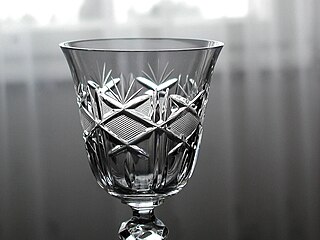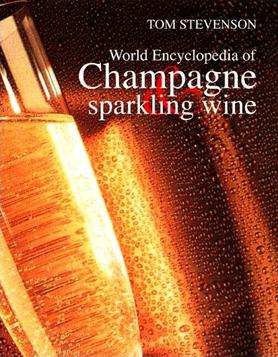
Glass is a non-crystalline solid that is often transparent, brittle and chemically inert. It has widespread practical, technological, and decorative use in, for example, window panes, tableware, and optics.

Decantation is a process for the separation of mixtures of immiscible liquids or of a liquid and a solid mixture such as a suspension. The layer closer to the top of the container—the less dense of the two liquids, or the liquid from which the precipitate or sediment has settled out—is poured off, leaving the other component or the denser liquid of the mixture behind. An incomplete separation is witnessed during the separation of two immiscible liquids. To put it in a simple way, decantation is separating immiscible materials by transferring the top layer to another container. The process does not provide accurate or pure product.

Lead glass, commonly called crystal, is a variety of glass in which lead replaces the calcium content of a typical potash glass. Lead glass contains typically 18–40% lead(II) oxide (PbO), while modern lead crystal, historically also known as flint glass due to the original silica source, contains a minimum of 24% PbO. Lead glass is often desirable for a variety of uses due to its clarity. In marketing terms it is often called crystal glass.

Baccarat is a French luxury house and manufacturer of fine crystal located in Baccarat, Meurthe-et-Moselle, France. The company owns two museums: the Musée Baccarat in Baccarat, and the Musée Baccarat in Paris on the Place des États-Unis.
Wine accessories are things that may be used in the storage or serving of wine. Wine accessories include many items such as wine glasses, corkscrews, and wine racks.

Riedel Crystal is a glassware manufacturer based in Kufstein, Austria, best known for its glassware designed to enhance different types of wines. According to Petr Novy, Chief curator Museum of Glass and Jewellery in Jablonec nad Nisou, Czech Republic, Riedel is the oldest family owned and operated global crystal glass brand worldwide. Established in Bohemia in 1756, the company is managed by Georg Riedel and Maximilian Riedel. Later, it was re-established by Claus J. Riedel in 1956, with the support of the Swarovski family.

A wine glass is a type of glass that is used for drinking or tasting wine. Most wine glasses are stemware (goblets), i.e., they are composed of three parts: the bowl, stem, and foot.

Beer glassware comprise vessels made of glass, designed or commonly used for serving and drinking beer. Styles of glassware vary in accord with national or regional traditions; legal or customary requirements regarding serving measures and fill lines; such practicalities as breakage avoidance in washing, stacking or storage; commercial promotion by breweries; artistic or cultural expression in folk art or as novelty items or usage in drinking games; or to complement, to enhance, or to otherwise affect a particular type of beer's temperature, appearance and aroma, as in the case of its head. Drinking vessels intended for beer are made from a variety of materials other than glass, including pottery, pewter, and wood.

Edinburgh Crystal was a cut glass manufactured in Scotland from c. 1820s to 2006, and was also the name of the manufacturing company. In addition to drinking glasses, Edinburgh Crystal made decanters, bowls, baskets, and bells, in several ranges.
The Hauptman-Woodward Medical Research Institute (HWI) is an independent, not-for-profit, biomedical research facility located in the Buffalo Niagara Medical Campus affiliated with the University at Buffalo. Its focus is on structural biology with a strong history in methods development and the application of X-ray crystallography in fundamental studies.

A champagne glass is stemware designed for champagne and other sparkling wines. The two most common forms are the flute and coupe, both stemmed; holding the glass by the stem prevents warming the drink. Champagne can also be drunk from a normal wine glass, which allows better appreciation of the flavor, at the expense of accentuating the bubbles less.

The Glencairn whisky glass is a style of glass intended for drinking whisky, developed and produced by Glencairn Crystal Ltd, in East Kilbride, a town near Glasgow, Scotland since 1981; originally designed by Raymond Davidson, managing director of the company. The shape of the glass is derived from the traditional nosing copitas used in whisky labs around Scotland. The glass design was concluded with the aid of master blenders from five of the largest whisky companies in Scotland. The glass first came into production in 2001. Since then, additional mini-Glencairns and Canadian Glencairns were introduced.

Christie's World Encyclopedia of Champagne & Sparkling Wine is an encyclopedia written by Tom Stevenson and Essi Avellan, published by Absolute Press, which is devoted to subjects relating to Champagne and sparkling wine. The foreword is written by Michael Broadbent. A smaller reduced version, Champagne & Sparkling Wine Guide, is published in the soft cover format.

Elegant glass is high quality glassware created in the United States during the Depression Era. It was sold for high prices in department stores and given as wedding gifts. Although part of the Depression Era, it is considered by most to be a separate category or sub category of Depression glass. When new, Elegant glass would cost more than standard Depression glass, because it was at least partially handmade, had a cleaner finish, and more vibrant colors. From the 1920s through the 1950s, Elegant glass was an alternative to fine china. Most of the Elegant glassware manufacturers closed by the end of the 1950s, and cheap glassware and imported china took its place.
Natalie MacLean is an accomplished Canadian Wine Expert, winner of the James Beard Award and author of New York Times Best Selling book 'Red, White and Drunk All Over' and others books. In spring 2023 her latest book 'Wine Witch on Fire' exposes the downside of the Wine Industry and its effect on those who toil in it.

The china service of the Lincoln administration generally refers to a set of purple-banded china (porcelain) dishes used for serving and eating food at the White House, home of the president of the United States for state dinners. Also known as the Lincoln solferino china service, it was purchased in April 1861 by First Lady Mary Todd Lincoln. The porcelain was manufactured by Haviland & Co. in France, and some of the decoration of the china was made overseas. Additional decoration was made by the American firm of E. V. Haughwout & Co., which sold the china to Mrs. Lincoln.
Claus Josef Riedel was a Czech glassmaker, businessman, professor of chemistry, and chemical engineer. He was the 9th-generation owner of Riedel Crystal, an Austrian glassware manufacturer that was established in 1756. Riedel is best known for creating and producing grape variety-specific glassware designed to enhance types of wines based on specific properties of individual grape varieties. He was among the first glassware experts in history to recognize that the taste of wine is affected by the shape of the glass from which it is consumed, and is credited with first discovering the concept of variety-specificity in glassware, developing variety-specific glassware shapes and bringing these glasses to the consumer market. Riedel served as President and Chief Executive Officer of Riedel Crystal from 1957 until 1994.
Georg Josef Riedel is an Austrian glassmaker and businessman. He is the 10th-generation owner of Riedel established in 1756 and best known for its production of grape variety-specific glassware designed to enhance types of wines based on specific properties of individual grape varieties. Georg Riedel joined the family business in 1973 serving as accountant, before rising to co-CEO of Riedel Crystal alongside his father, Professor Claus Josef Riedel, from 1987 until 1994. He served as chief executive officer from 1994 until 2013. Georg Riedel succeeded his father, who first developed the concept of wine-enhancing glassware in 1958, and is best known for bringing variety-specific wine glasses to a global audience.

Krosno Glass S.A., commonly known as Krosno, is a glassware and crystalware company from Poland. It has been in operation since 1923 and specializes in the production of high-quality glass accessories or liquid vessels such as jugs, vases, carafes, decanters and chalices as well as stemware and tumblers for serving spirits. The products are available in over 60 countries worldwide.

Cut glass or cut-glass is a technique and a style of decorating glass. For some time the style has often been produced by other techniques such as the use of moulding, but the original technique of cutting glass on an abrasive wheel is still used in luxury products. On glassware vessels, the style typically consists of furrowed faces at angles to each other in complicated patterns, while for lighting fixtures, the style consists of flat or curved facets on small hanging pieces, often all over. Historically, cut glass was shaped using "coldwork" techniques of grinding or drilling, applied as a secondary stage to a piece of glass made by conventional processes such as glassblowing.














